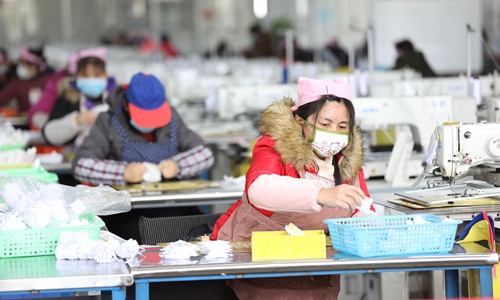As virus spreads worldwide, China’s economic growth outlook dims
As virus spreads worldwide, nation’s economic growth outlook dims

Workers start manufacturing at a shoe factory in Central China's Hunan Province on February 11. Photo: cnsphoto
The Chinese economy remains under immense pressure from the fallout of the COVID-19 pandemic, although effective virus containment by the government lays the basis for revival hopes, Chinese analysts say.
Expectations for the release of pent-up spending after the epidemic ends might not come true, dashing hopes for a consumption-driven recovery to offset the coronavirus-incurred losses in exports.
A prudent approach to recommencing economic activity while preventing a virus resurrection is imperative, Zhang Yansheng, chief researcher at the China Center for International Economic Exchanges, told the Global Times on Wednesday.
A weekly index published by Chinese internet behemoth Baidu's map division that measures the restart of business operation and production tallied at only 69.95 percent as of March 17.
For one thing, the nation has been "too conservative in reactivating its economy", with many small tradespeople, among a multitude of businesses, yet to resume normal operations, Zhang said.
For another, normalization of economic and social activities in China itself would be insufficient to put the economy back on track, as the disease has engulfed Europe and the US, freezing those economies and causing severe disruption to global supply chains, he noted.
China's economy is widely believed to have been pummeled harder by the coronavirus than the 2008 global financial crisis. Domestically, the disease has been gradually contained in middle March, and consequently an uptick in consumption and investment is expected from this month.
But the results won't be that rosy, which suggests that China is highly likely to "record negative GDP growth" for the first quarter, said analysts at China Lianhe Credit Rating Co in a note sent to the Global Times on Wednesday. The annual growth target the market had previously agreed on would be hard to achieve, the note says.
The Chinese economy grew 6 percent in the fourth quarter of 2019 and its full-year growth weakened to 6.1 percent, the slowest pace in nearly three decades.
China International Capital Corp (CICC) forecast in a research report earlier this week that the economy is on pace to contract in the first quarter and record an annual expansion of only 2.6 percent due to virus-related woes.
The Chinese investment bank ratcheted up its actual China GDP growth forecast for 2020 to 6.1 percent from 5.9 percent back in early January, citing a possible easing of China-US trade frictions and China's ramped-up policy support for stabilizing growth.
It is likely that annual growth might even fall short of CICC's prediction, if work and production resumption continues at the current pace and the global pandemic sees no imminent signs of abating, Zhang commented.
A normalization of economic activity in the second quarter would still be slow considering that "many of China's curbs on social interactions will remain in place to prevent a renewed outbreak," analysts at Moody's said in a note to the Global Times.
Market observers also argue against relying on pent-up consumption to mitigate sluggish exports.
The epidemic would weigh on domestic consumption - with tourism, cinema, and other outdoor activity-related sectors taking a huge hit from the coronavirus-induced restrictions, but lead to an increase in layoffs, China Lianhe Credit Rating's analysts noted.



